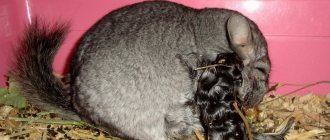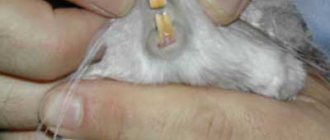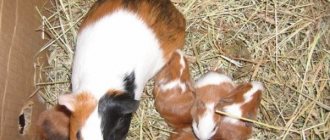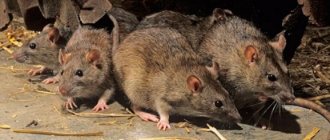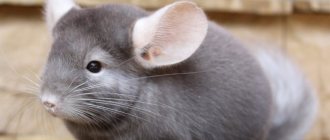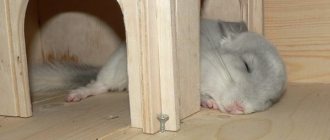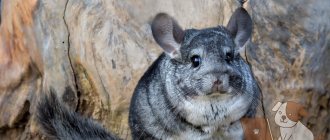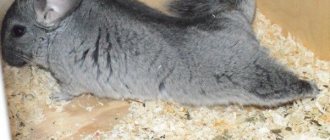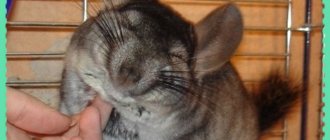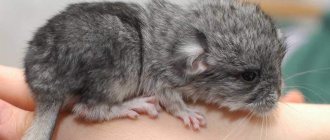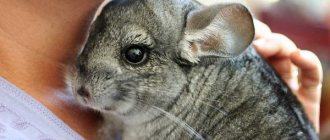Chinchilla pregnancy
Chinchillas can mate at any time of the year; they do not have so-called mating seasons. With a life expectancy in captivity of 15–20 years, a female can give birth before reaching 13–15 years of age.
Did you know? The chinchilla has a special skeletal structure, thanks to which it can narrow vertically and crawl through even very narrow openings and crevices.
Puberty
Sexual maturity of these rodents occurs at 6–7 months of age in females and at 9 months of age in males. Although some individuals may begin estrus even at 3–4 months. It is recommended to mate the animals when the female is one year old and weighs at least 0.5 kg, and the male is 2–3 months older. At this time, the female’s body will be completely ready for childbirth. But getting pregnant too early will not do her any good. Firstly, she may not give birth or gestation will proceed with problems, and secondly, she will become aggressive towards the male and offspring.
The female's sexual heat lasts 28 days. During this period, she goes into estrus for 3 days, during which vaginal secretions are released. It is at this time that she will need to be mated.
For mating, the female is placed in a cage with the male. Mating occurs at night. Animals usually produce it quite noisily.
If mating has occurred, then when cleaning the cage you can find a plug from the female’s vagina, consisting of the male’s seminal fluid. She comes out 12 hours after mating.
Learn how to make a cage, a hammock, a wooden display house and the display itself for a chinchilla.
How often and how many cubs are born?
A chinchilla can become pregnant 1-3 times a year. However, veterinarians do not advise giving birth to these animals more often than 2 times every 12 months, since frequent births negatively affect the health of the mother. The female can become pregnant again on the first day after giving birth.
One litter produces from 1 to 6 cubs.
How long does pregnancy last
Pregnancy lasts 105–125 days. Its duration depends on the breed, the health of the expectant mother and the number of babies being carried.
Important! It is better to separate the male from the female 2–3 weeks before and after birth.
A chinchilla that has already given birth behaves restlessly, excitedly, and screams. It is believed that if she mates on the first day, she calms down faster and focuses on maternal function. However, there is no confirmation of this opinion.
How to breed chinchillas at home: technique for beginners
There are two types of breeding - polygamous, when one male serves 3-5 females, and monogamous or paired, when permanent pairs are formed. The latter has a number of advantages. When animals are kept in pairs, they are calmer, less stressed, and their mating is more likely to be successful.
- To breed chinchillas, you should first introduce them. You can even do this in different cells, simply by placing them next to each other. They get to know each other by smell. This period can take from 2 weeks to 1 month. You can accustom them to the smell by swapping animal cages.
- Female chinchillas are larger, more aggressive and dominant. Therefore, you only need to place the female with the partner!
- Once they have settled down next to each other, they can even be taken out for a short walk together under strict supervision.
- For planting, use another, larger cage - it must be washed. Remove as many shelves and toys as possible, but leave the labyrinth. The male can hide in it in case of an attack. Be sure to provide a swimming pool with sand.
- Before setting them off, it is recommended to bathe them in the sand with the feces or urine of their partners. During the mounting - from 3 to 4 hours - you must be near the cage in order to provide timely assistance. If after this time no incidents have arisen, then you can leave them to get acquainted further.
- But still, on the first day you should not lose vigilance. Focus on nutrition and arm yourself with patience - animals do not always immediately want to have offspring. Tip: Place a lot of hay or grass on the bottom. Eating greens will distract their showdown.
Important: Evidence of mating will be shreds of fur on the floor, downed hay and the presence of white strands (dried seminal fluid). The process itself lasts several seconds, while the male actively grabs the female with his teeth. After fertilization, in order to avoid infection and repeated intercourse, a protective plug is formed in the female.
The mating process occurs at night, photo of vaginal plugs
How to tell if a chinchilla is pregnant
You can notice that a chinchilla is pregnant based on several signs:
- she suddenly gains weight;
- she is not in estrus for 30 days after mating;
- nipple swelling occurs 8 weeks after mating;
- there is an increase in appetite;
- activity decreases - the animal sleeps and eats more than moves and plays;
- urination becomes more frequent.
At home, the surest ways to find out about pregnancy are to weigh the female before mating and after 2 months (this can be done on a regular kitchen scale) and monitoring the presence of estrus.
Video: How to determine pregnancy in chinchillas Veterinarians perform ultrasound and x-rays to determine whether a female is pregnant or not. Ultrasound examination allows you to see fertilization in the early stages of pregnancy, X-ray - in later stages.
In order to calculate the date of birth, after the first mating you should keep records that indicate the time and duration of estrus, the number and dates of matings, changes in the behavior of the female, her weight, etc. In the future, these records will help to prepare correctly and on time for childbirth.
Important! When weighing a chinchilla, it is strictly forbidden to pick it up by the tail. This can cause injury to the embryos and the animal itself.
To breed chinchillas, do you need to create the right conditions and choose a pet?
Your first task in order to breed chinchillas is to choose and equip the right room for chinchillas!
Important: The volume of your business directly depends on the area that you are willing to allocate for keeping chinchillas. The minimum cage size for one animal should be 50x50x70 cm (W*D*H). But the larger the cage, the more comfortable the animals feel, the higher their birth rate. Animals should not be allowed to be kept in cramped cages or irregularly shaped cages - round, narrow, multifaceted; this has a negative impact on their psyche, health and reproduction of offspring.
- The house should be dry, bright, and the temperature should be maintained within 20°C. Violation of the temperature regime, dampness and poor lighting adversely affect the health and productivity of animals. Cages in the room should be located in such a way that they are convenient to clean and care for chinchillas.
- It would be a good idea to think in advance about feed and the possibility of purchasing it in bulk. Breeding chinchillas need to be fed high-quality ready-made food with the addition of grains and greens. The same applies to sand. You cannot save on sand by collecting it somewhere in natural conditions; this can result in infectious contamination and the death of all animals.
You can read complete information about the correct choice of house, its arrangement, and the choice of permitted and necessary products in our material “Rules for keeping and feeding chinchillas at home.”
Create the conditions first
Only healthy chinchillas should be bred. And there are some tips on how to determine this.
- Of course, we pay attention to the fur! There should be no pellets. It should be even, moderately fluffy and smooth.
- Stroke the fur against the grain. This needs to be done by examining the skin and the fur itself for the presence of lice, mites, dried particles of pus and other inflammatory lesions.
- the animal’s muscles before purchasing, because it is not visible behind the fur. The rodent should not have protruding chest bones - this can be a signal of illness, as well as excessive exhaustion. Although it could also be poor nutrition. Obesity also needs to be excluded.
- Examine the anus - it should be covered with hair. But it should not be stuck together - this indicates possible diarrhea.
- Pay attention to the eyes - they are expressive, shiny and without purulent or tearful discharge. Yes, sometimes this can be a signal that the animal has dust in its eye. But this could also be a signal of a possible draft or infectious disease (especially if there is discharge from both eyes).
- The chinchilla's nose should also be free of mucus and dry and clean. Sneezing is a signal of a cold or dusty conditions.
- The ears are also clean, with no scabs on the outer or outer ear. Otherwise, this may indicate a tick infestation.
- Breathing is even, without whistling. The chinchilla itself is mobile and active, often does not rub its face with its paws, and does not drag its tail.
You need to purchase chinchillas for breeding from nurseries or farms where breeding work is carried out. It is important that they come from different breeding lines and families with high fertility and are healthy. It is advisable to have a veterinary certificate about the pedigree and health of the animal.
Varieties of color
How to care for a pregnant chinchilla
Caring for a pregnant chinchilla will be somewhat similar to caring for a woman carrying a baby. First of all, care should be taken to ensure that the animal is not nervous, stressed, or injured. There should be no bright light or loud sounds in the room where it lives.
To protect the female from injury, she should be held less often and ladders and shelves should be removed from the cage. It is advisable that the male live separately from the female during pregnancy. Otherwise, he may attempt to mate, which could cause harm to the embryos.
If possible, then in the later stages you should take the chinchilla for an x-ray to make sure that the babies are in the correct position in the womb and that there are no threats to the normal course of labor.
The cage will need to be cleaned every day. It is advisable to use hay as bedding during this period.
Read about how to tame a chinchilla to your hands, tray, name.
Appropriate adjustments must also be made in diet. So, the diet should increase the amount of proteins from protein foods and reduce the amount of roughage (by about 25%). The following products are added to the regular menu:
- sprouted oats and wheat;
- nettle leaves;
- fresh apples;
- rose hip;
- cereal with dry milk.
At the pet store you can purchase special food designed for a pregnant female, which includes all the necessary minerals and vitamins. Fresh food and water should be available at all times in the feeder and drinking bowl.
Did you know? To make one fur coat, it takes from 100 to 300 chinchillas.
Chinchillas: breeding questions and answers (FAQ)
— How to determine the gender of a chinchilla?
Unfortunately, an inexperienced chinchilla breeder often makes mistakes when determining the sex. Call a veterinarian or a chinchilla breeder who has a lot of chinchillas and keeps them for at least two years. They will help you determine. You can, of course, write that the external genitalia of females and males are very similar in appearance, and the only difference is that in males the distance from the anus to the penis is greater than in females: But this is unlikely to help in the absence of experience in determining sex in chinchillas. Best of all, find high-quality photographs of chinchillas’ external genitalia and, when examining, compare what you actually see with the photographs. As a rule, after 3 months, the external genitalia of males look quite “convincing.”
— How many babies is born to a chinchilla on average?
According to biology, chinchillas normally have four active nipples. Hence the conclusion: four cubs is the norm. As a rule, from 1 to 3 cubs are born. Females with low milk supply, with more than 2 puppies at birth, may not have enough milk for all, so it is necessary to supplement the weakest ones. Now let's think a little. Why do captive chinchillas usually have fewer babies? There are several possible reasons: 1) All the hundreds of thousands of chinchillas living in captivity around the world are descendants of 2-3 dozen chinchillas. Those. The gene pool of this population is extremely limited. 2) Most chinchillas live in VERY cramped conditions. And ask yourself the question, who will reproduce normally in a concentration camp?! 3) Chinchillas often have an unbalanced diet: excess protein or fat leads to a decrease in fertility and survival of puppies in the first month. In good home conditions, with two litters per year, a good female regularly gives birth to 3-4 healthy puppies.
— Which mixture is suitable for feeding chinchilla puppies?
When selecting a formula for feeding (additional feeding), you should take into account the composition of chinchillas’ natural milk. Composition of chinchilla milk : fat - 14%, carbohydrates - 1.7%, protein - from 6.4% on the first day to 8% on the tenth day of lactation. It is vitally important for puppies that the female has milk for three weeks. It is best to choose a soy-based breast (human) milk replacer (this could be, for example, Similac) to avoid the danger of lactose indigestibility.
— How many times a year does a chinchilla give birth?
Chinchillas give birth infrequently (2-3 times a year) and little by little - on average 2-3 puppies. Babies born at maturity are sighted, with teeth and fur. Having dried, after 2-3 hours, they are completely ready for life and willingly “travel” around the cage.
— Until what age do chinchillas gain weight?
It is believed that animals on farms reach full size and weight by 8-9 months. According to my observations, at home, up to 8-10 months, the animal grows, so to speak, in length (increases in size), and then, up to one and a half years, “matters” (expands in breadth, gains weight), mainly due to the increase muscle mass. A prerequisite for such development is a combination of a balanced diet with sufficient exercise.
— How many grams per day should chinchillas add?
It depends on how many animals are in the litter, how large their parents are, how complete and lactogenic the female’s diet is, etc. I observed that if a large female has 4 babies, they are born weighing about 40-45 g, gain 2 g per day in the first three weeks, and add more in subsequent weeks. If the same female has 2-3 puppies in the litter, they are larger at birth (about 50-55 g) and gain 4 g in weight every day. And when 1 puppy was born, he gained 4-6 g per day almost from the day of his birth. It is dangerous if the baby not only does not gain weight, but even loses it. Or when he gains 2-4 g, he loses it again. In this case, it is necessary to supplement the diet with soy milk replacer “Similac” and find out the reasons for such weight fluctuations.
Preparing the cell for birth
It is better if the chinchilla gives birth in the cage in which she lived before giving birth. In rare cases, she is provided with a separate cage, for example, for hamsters or guinea pigs, but this is additional unnecessary stress for the animal.
During the entire pregnancy and immediately before childbirth, the cage must be kept perfectly clean. During childbirth, food, water and a toilet should be available to the woman in labor. It's better to get rid of other things. The bathtub is removed 5–6 days before birth. It will need to be returned to its place 2 weeks after the birth of the babies.
So that the female can have privacy during the birth process, a spacious house is placed in her cage. The entrance should be convenient not only for the woman in labor, but also so that the owner can replace the bedding and examine the mother and offspring.
Formation of a couple
Before mating, you need to select a pair, paying attention to the following points:
- the animals must match each other according to breeding data;
- have good pedigrees;
- have good health;
- have similar color and quality of fur;
- the couple should not consist of close relatives up to the third generation of kinship.
When forming couples, it is also necessary to take into account the age of the partners. Females reach sexual maturity at 6-9 months. It is advisable to choose a male that is 2-3 months older for her. If the female is older than a year, on the contrary, it is recommended to choose a male 2-3 months younger for her. But this condition is not mandatory.
To give birth to viable offspring, the female and male must be in excellent physical shape. You need to know that emaciated or, on the contrary, obese animals can produce sick or weakened puppies. It is quite possible that the female will not become pregnant at all.
Before mating, you should determine the relationship of the partners to each other. To do this, they are first placed in different cages, but placed at a close distance. This way the animals will be able to get somewhat used to each other. Then an attempt is made to place the couple together. If a calm relationship has been established between the animals, they do not quarrel or fight, then the replanting was successful.
Females are generally larger, stronger and more aggressive than males. If there is no peaceful life between the animals, on the contrary, there is aggression, then the failed pair should be separated and other options for mating should be selected.
Chinchillas recognize each other by smell, and if one animal has already been living in a cage for some time, then it may try to drive the newcomer out of it. If this happens, there are several ways to reduce the old-timer's aggressiveness. For example, placing a cage with a new animal next to an old cage. In 2-3 days, the animals will get used to each other’s smell, after which you can try to place them together, and if unsuccessful, place them again, changing places. After a few days, you can try again.
You can try placing a small (transport) cage with a newcomer inside a large cage with an old resident for 4-5 hours. The animals will make contact, but will not be able to fight.
A successful option may be to lock the old resident for 3-4 hours in a small cage located inside the large one into which the newcomer is released. The latter, moving freely, will leave its smell in all corners of the cage and accustom the “owner” to it. When the old-timer is finally released from the small cage, he will treat the newcomer with “respect.”
Usually fewer problems arise when forming a pair of young individuals. Animals most easily get used to each other at the age of six months, immediately after reaching sexual maturity, and they can be used for breeding until they reach the age of ten.
The time for active mating of animals in natural conditions is from November to May, in captivity – from November to April. By changing the behavior of animals, one can determine their readiness to reproduce. The male begins to actively court the female, running after her around the cage, snorting loudly, and wagging his tail. The female is restless, eats poorly, and scatters food around the cage. All these signs indicate that the couple has formed, and it will not delay the start of reproduction.
Chinchillas rut approximately every 40-41 days. This period can vary from 30 to 50 days. The duration of the rut is from two to seven days. The female accepts the male’s “signs of attention”; during estrus, she lifts up the back of her body and seems to stretch out in front of her suitor, indicating her readiness to mate.
How does childbirth go?
As a rule, childbirth occurs in the morning. Their course normally lasts up to 2.5 hours. The onset of childbirth is preceded by characteristic changes in the behavior of the female.
Signs of approaching labor
You can find out that a female is about to give birth not only by counting the days on the calendar, but also by her actions. Thus, one of the main factors in the approaching birth is the construction of a nest - increasingly, a chinchilla can be found chewing the straw bedding to make it softer. She takes the softened straws to one corner. It also stores its plucked wool there. Construction of the nest lasts about 2–4 days.
You will probably be interested to know how many years chinchillas live in wild and domestic conditions.
After the nest is built, the female falls into a state of rest - she lies a lot, sleeps, practically does not eat, and often rests on her side or back.
Before giving birth, her body weight decreases by 15–25 g, and her rectal temperature decreases by 1–1.2 degrees. There is a drooping of the abdomen, drooping of the sides, and swelling of the genitals.
How to prepare
Closer to birth, the owner should prepare moisture-absorbing diapers, hydrogen peroxide, disposable syringes, saline solution, milk replacer, and also put the veterinarian’s phone number in a visible place. All these items will be necessary if something goes wrong during childbirth and the mother and her babies need help.
What to do, how to help
Like most animals, when a chinchilla gives birth, it does not require outside help. Usually childbirth proceeds quickly and without problems. The intervals between the appearance of babies range from several minutes to 1–2 hours.
Find out more about the types and colors of chinchillas.
After all the babies come out of the womb, the placenta appears. The chinchilla eats it. However, problematic births also happen. This happens when the fetus is too large or is not positioned correctly in the womb.
Problems also arise if:
- the female was ill during pregnancy;
- the woman in labor is too young;
- The chinchilla was injured while she was pregnant.
Childbirth can be classified as pathological if the following situations occur during it:
- the interval between the appearance of cubs is 4–6 hours or more;
- the baby is not born within 20–30 minutes, but some part of his body appears from the vagina;
- profuse uterine bleeding began;
- no contractions;
- the female is in an emaciated state.
In order to pay attention to the pathology in time and provide assistance to the woman in labor, you should carefully monitor the birth process and record the time of birth of the babies and the intervals between their appearance.
Important! All of the above situations require an immediate call to the veterinarian.
If for some reason it is not possible to get veterinary help, then the owner of the chinchilla can help her only if the baby is stuck in the vagina - for this, the part that has already appeared must be carefully lubricated with Vaseline and pulled lightly during contractions.
In other situations, an inexperienced person will not be able to help. In case of problematic childbirth, it is still necessary to take the woman in labor to a veterinary center, where she will receive qualified assistance and, if necessary, a caesarean section will be performed.
How babies are born
Chinchilla offspring are born weighing 30–60 g with open eyes and teeth and can almost immediately move independently over a short distance. Usually after some time they hide under their mother to dry out and warm up.
At first, babies eat mother's milk. Lactation begins one day after birth. Newborns feed on colostrum for 24 hours.
If for some reason they miss him, the owner will have to feed the kids. To do this, prepare a mixture of condensed milk without sugar and chamomile infusion in a 1:2 ratio. It is warmed to room temperature. Feeding is done with a syringe without a needle for the first 7 days every 2 hours, the second 7 - at an interval of 4 hours, the third week - at an interval of 6 hours.
At 2 months, small chinchillas will weigh about 80-90 g, at 12 months - 120-130 g. They are ready for independent life from 3 months.
So, if you are planning to breed chinchillas, then you need to prepare for this process, namely: create the required conditions (for example, purchase an additional cage for the male, who will need to be placed during pregnancy and the first time of feeding the babies); find a veterinarian who could provide assistance if necessary; decide whether you can provide the female with high-quality nutrition, care and observation during pregnancy, as well as provide artificial supplementary feeding to the babies, if necessary.
The process of childbirth in a chinchilla
Most often, chinchillas give birth early in the morning. However, females that feel safe and have already given birth can give birth both during the day and at night. Immediately before giving birth, the female’s behavior changes dramatically: she becomes restless, can show aggression, constantly looks to her sides, moans or whistles. The prenatal period can last from several hours to a day.
When these symptoms occur, it is better to cover the cage with a dark cloth so as not to irritate the animal with light, sounds, or movement.
Contractions indicate that the female is beginning to give birth to babies. You can notice them by the wave-like contraction of the abdominal muscles. Rare and light contractions, expressed in periodic contractions of smooth muscles, stimulate the movement of the cubs in the desired direction. When babies find themselves in the uterine cavity, contractions become more frequent - the membranes rupture and amniotic fluid comes out. By this time, the genital slit is already completely open.
After intense contractions, there comes a turn of pushing, during which the smooth muscles of the abdomen contract. During the pushing, the baby is born. If contractions are an uncontrollable process, then the female can easily control the pushing herself. Most often, females give birth standing, resting their paws on the floor, but some prefer to give birth in a lying position or even on their side.
Attempts can continue for several hours. During normal labor, babies are born at intervals of fifteen minutes to two hours. During this time, the female manages to remove the film from the child, lick him and rest a little before the release of the placenta or the appearance of the next baby. If the intervals between attempts are less than fifteen minutes, then after the birth of one baby the female will not have time to remove the film, which threatens the death of the baby. In this case, the owner's assistance is required. His task is to carefully remove the film from the newborn and rub it with a clean napkin.
The afterbirth most often appears at the end of childbirth and is usually eaten by the female. This is explained by the content of important hormones in the afterbirth, which stimulate contractions of the uterine walls and milk production.
Postpartum period
Females who have given birth for the first time often experience postpartum stress. For them, what is happening is not entirely clear. This can be noticed by restless behavior, aggression and rejection of children. Usually the maternal instinct is still stronger and the female accepts the cubs after some time.
Therefore, do not panic if immediately after giving birth the chinchilla refuses to feed the babies.
Just a day after the chinchilla gave birth, she is already ready for another mating. However, this will lead to a lot of stress. Therefore, if the female gave birth in the same cage with the male, he must be placed in another cage for two to three days. After three days, the male can be returned home - he will help the female take care of the cubs.
The diet of a nursing chinchilla is not much different from the diet before and during pregnancy. It is recommended to feed the female with the most pure and vitamin-rich food possible. It’s good to add cottage cheese, milk (powdered) and fresh eggs to your diet. It is recommended to make an additional feeder for nettles, leaves and fruits of rose hips, hawthorn and strawberry leaves, which is placed next to the nest. An additional drinking bowl is also hung next to the nest.
The chinchilla has three pairs of nipples, but not all of them are active. Most often, the first and second pair are dairy. If babies suck nipples, then even in inactive ones milk appears over time. The breeder needs to monitor the feeding of the pups, since sometimes not all puppies have enough milk. Strong cubs often push away weak ones, which leads not only to slower growth and development, but also to death. If some puppies are stunted, they need to be artificially fed.
For feeding, use a mixture of one part unsweetened condensed milk and two parts chamomile infusion.
The mixture is heated in a water bath to room temperature and the babies are given small portions from a syringe without a needle several times a day.
Readiness for mating (estrus)
Like many animals, female chinchillas have a period of estrus (hunting) when they are ready to mate and, moreover, desire it. On average, estrus lasts from 2 to 5 days, then the mating process may become unsuccessful.
Determining whether a chinchilla has started hunting is not difficult. Her behavior gives her away very much; she begins to throw everything around and creates complete chaos in her cage. Along with active behavior, the female eats very little or not at all.
The second sign is external signs. The genitals swell and become bright pink.
Chinchilla gave birth - your actions
- It happens that a new mother leaves her puppies on the floor. Since they are born wet, it is necessary to dry them and wrap them in a warm cloth. Also, take care of the food, for this you can use an artificial milk formula; you need to feed it using a pipette. After you have completed all these important steps, the babies need to be placed under their mother’s tummy, where they will be warm and cozy.
- After 5–6 hours, the puppies must be examined. Look at the anus of each individual. If the baby has performed an act of defecation, it means that traces of primary feces will remain on the fur near the anus. If intestinal peristalsis is absent in a newborn in the first day of life, this may well lead to the development of inflammation of the anus, and possibly intestinal prolapse.
Important. You should not stop the inflammatory process on your own or try to reset prolapsed intestinal loops. The baby urgently needs professional help, go to the vet.
Source
Female nutrition during pregnancy
To get healthy offspring, it is necessary to provide the female with balanced food and slightly increase the portion. Carefully monitor the quality of food so that the chinchilla does not get poisoning or other digestive diseases. Because treating them during pregnancy is doubly more difficult.
Be sure to include in your diet:
- High-quality hay, without debris, rot and mold
- Pelleted feed
- Keep the water clean
- Dilute dry food with fresh vegetables and herbs, but only in small quantities.
- Leaves and branches of trees
- Dried
Remember that you need to be careful with healthy nutrition. You may think that fresh vegetables are the ideal food for your pet, but you will end up with dangerous illnesses such as bloating, constipation or diarrhea. Juicy food is very dangerous for chinchillas, because it causes gas formation in the stomach, and she cannot get rid of them on her own. Therefore, succulent food should make up less than 25% of the daily intake of the total feed.
There are often recommendations on forums that chinchillas in the second phase of pregnancy should be given calcium gluconate. The dose is half a tablet; it helps the development of the fetus and strengthens its bone tissue.
You will find many articles on breeding and caring for chinchillas after birth on our website. Now I will give you links to the most important of them, so that you know all the nuances of chinchilla breeding and what it requires. Not many people are involved in the chinchilla breeding business; competition is quite low. This is due to the fact that the demand for them is not so huge, but there is always a hunt for beautiful colors, because it is almost impossible to find them in pet stores.
Baby care
The body weight of newborn chinchillas ranges from 30 to 70 grams and depends on heredity, litter size and mother’s feeding during pregnancy. Full-term chinchillas are born with teeth erupted, sighted, covered with fur, and capable of independent movement. A week after birth, the puppy already tries food, but continues to feed on milk until 1.5–2 months.
While breastfeeding, the chinchilla is prone to losing weight, so she needs to be provided with very good nutrition. Milk can be added to the diet.
The first 2 weeks are considered critical for the cubs. The room temperature should be maintained around 20° C.
The young are separated from their mother at the age of two months, and the babies weigh 200–250 grams. In general, chinchillas are very good mothers, and problems with caring for their offspring rarely arise. Healthy babies are cheerful, calm, and wag their tails. The weak have no appetite and are lethargic. The reason for this may be a lack of milk from the mother chinchilla. In this case, the cubs are fed artificially. Unfortunately, there are also situations when babies are left orphans due to the death of their mother or the female does not have milk (this can happen due to stress or illness), and hungry babies squeak heavily and become weak. If this happens, then the puppies have to be fed themselves - for this you need to prepare a mixture similar in fat content to chinchilla milk. For these purposes, it is better to choose lactose-free infant formula or milk powder for kittens. You can also feed chinchillas with boiled cow's milk, or better yet, goat's milk, adding a drop of butter. When the tummy is bloated, it is recommended to do a light massage.
Chinchillas are fed from a pipette or from a syringe without a needle; it is more convenient to use an insulin syringe. The mixture is calculated as follows: 10 ml per 50 grams of baby’s weight. That is, when feeding every two hours, a chinchilla weighing 50 grams should receive about 0.8–0.9 ml of the mixture at a time. If the mixture is suitable, then the babies begin to gain weight, they should not have diarrhea or constipation. During the first week, puppies are fed every two hours; in the second week of life, the interval between feedings can be increased to three hours. If the puppies are orphaned, they additionally require heating using a heating pad or a bottle of warm water.
Should the male be separated from the female after giving birth?
Males are different and can treat babies with aggression. And even the kindest male can run over or injure a chinchilla through negligence, simply by jumping poorly. Plus, almost after giving birth, the male can cover the female again, and this, of course, will not benefit her at all. It is undesirable to allow multiple births of offspring in a female, since frequent births exhaust the body. Of course, the female is capable of bearing offspring three times a year, but the cubs may be born weak and non-viable. Share with your friends:
